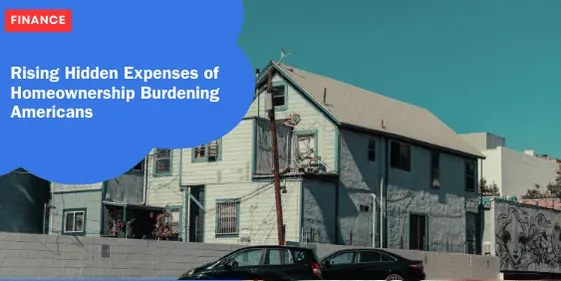Rising Hidden Expenses of Homeownership Burdening Americans

The cost of owning a home in the United States is rising rapidly, and this spike is not limited to just mortgage payments.
A new study conducted by Bankrate has revealed that U.S. homeowners are now spending an average of $18,118 annually on property taxes, homeowners’ insurance, maintenance, energy, and various other expenses related to home ownership.
This amount is equivalent to nearly the cost of buying a used car and signifies a staggering 26% increase from four years ago when it cost $14,428 yearly to own and maintain a home.
These variable expenses are in addition to the fixed cost of mortgage payments.
Homeowners must also budget for property taxes, homeowners insurance, energy costs, internet, cable bills, and maintenance, among others.
The findings serve as an eye-opener to how much more expensive life has become since the Covid-19 pandemic.
The Exponential Growth of Homeownership Costs
On Wednesday, new data underscored the burgeoning pressure Americans are experiencing from housing-related expenses.
Even as items such as food and gasoline have witnessed price drops, the cost of shelter has increased by 5.4% year-over-year in May, according to the Bureau of Labor Statistics (BLS).
This rise is significantly above the overall inflation rate of 3.3%.
Many Americans aspire to become homeowners but have found it increasingly difficult due to record-high home prices and persistent mortgage rates.
Currently, the housing market is historically unaffordable.
Even those fortunate enough to have purchased a home in the past few years are now grappling with the sticker shock of maintenance costs.
According to Bankrate, the monthly cost of owning and maintaining a home has soared from $1,202 in 2020 to $1,510.
Key Drivers Behind the Rising Costs
Jeff Ostrowski, an analyst at Bankrate, cited maintenance and insurance costs as the primary drivers behind the spike in homeownership expenses.
Home insurance premiums have surged in recent years, partly due to the increasing frequency of extreme weather events.
Jennifer Schauer, a homeowner in Novato, California, witnessed her homeowners insurance double unexpectedly.
“My homeowners insurance doubled, with no notice—nothing,” she remarked.
Schauer disclosed that several of her neighbors had lost their insurance coverage entirely due to the increasing risk of wildfires in the area.
“My neighbors said I was lucky our insurance just doubled and it wasn’t canceled,” she added.
Nationally, home insurance rates saw an 11.3% increase last year alone, as reported by S&P Global.
The U.S. homeowners insurance industry faced a loss of $101.3 billion last year due to severe storms, hurricanes, and wildfires causing significant damage.
Additionally, high inflation has made it more expensive to rebuild properties.
Hidden Costs and Their Implications
Hidden costs related to homeownership extend beyond routine maintenance and insurance.
Schauer, who is a paraeducator and mother of two, recently discovered that her home needs $10,000 worth of plumbing repairs.
“The housing market was so competitive when we bought, that to get this house we waived the homeowner inspection. We bought it as is,” she explained.
“We knew the plumbing was old but it’s falling apart.”
To manage these unexpected expenses, Schauer is taking on extra hours at school as a substitute teacher, accepting help from family to pay for her son’s tutoring, and cutting costs by avoiding dining out and canceling her home cleaning service.
Schauer’s situation is not unique among Californians grappling with high hidden costs of homeownership.
Bankrate found that the average cost of owning and maintaining a home in California is a daunting $28,790, ranking second among all U.S. states, just behind Hawaii.
The top five states with the highest hidden costs of homeownership are rounded out by Massachusetts ($26,313), New Jersey ($25,573), and Connecticut ($23,515).
On the other hand, states like Kentucky ($11,559), Arkansas ($11,692), and Mississippi ($11,881) had the lowest hidden costs, according to Bankrate.
Since the onset of Covid-19, the hidden cost of homeownership has climbed most rapidly in Utah (44%), Idaho (39%), and Hawaii (38%).
Silver Lining and Financial Flexibility
Despite these rising expenses, a silver lining exists for homeowners in the form of increased home values since 2020.
These gains have bolstered the net worth of millions of Americans. The Federal Reserve reported a median inflation-adjusted net worth growth of 37% from 2019 to 2022.
The real estate boom has also provided homeowners with additional financial flexibility, allowing them to borrow against the value of their homes to cover unexpected costs, finance education expenses, or upgrade their homes.
However, Ostrowski from Bankrate emphasized that these findings should serve as a “reality check” for first-time homebuyers.
“A lot of first-time buyers think of the closing table as the finish line,” he noted.
“But in another way, it’s just the starting line for all these new expenses you’ll be responsible for.”
Ostrowski advised buyers to consider these concealed expenses when calculating their mortgage affordability.
“You may have thought your financial hurdles were behind you after saving for a down payment,” he explained.
“However, as a homeowner, you need to allocate funds for these unforeseen expenses.”
Broader Economic Context
The broader economic landscape paints a complex picture.
The normalization of supply chains post-pandemic is a positive sign, hinting at potential stability in future pricing.
However, external factors such as geopolitical tensions, trade tariffs, and global market dynamics still pose significant risks.
Different sectors feel the impact of rising costs in varying ways.
Retailers may benefit from stabilized prices, whereas industries reliant on raw materials might struggle due to commodity price volatility.
Consumer behavior has notably shifted due to economic uncertainties.
Higher costs and elevated interest rates have led many consumers to prioritize essential spending over discretionary purchases.
Financial literacy and cautious financial planning have become more prevalent, with individuals becoming more attentive to savings, investments, and debt management.
The digital economy and technological advances present both challenges and opportunities.
Tech-driven industries face inflationary pressures, yet innovations in automation and artificial intelligence offer potential solutions to reduce operational costs and enhance efficiencies.
Long-term Strategies and Community Impact
Long-term strategies focusing on reforming supply chain vulnerabilities, addressing workforce shortages, and stabilizing the housing market are essential for maintaining economic stability.
Investments in infrastructure, green technologies, and education can foster resilience.
Community and social support systems play a crucial role in mitigating the financial burden on lower-income families.
Government policies must balance economic growth with social equity, ensuring access to affordable housing, healthcare, and education.
The political landscape is influenced significantly by economic management.
Transparency and effective communication about economic policies are crucial for garnering public trust.
Regular updates and clear explanations of data and measures can bridge the gap between policy actions and public perception.
Conclusion
The surge in hidden homeownership costs serves as a stark reminder of the complex financial landscape American homeowners navigate.
While rising home values offer some relief, the array of hidden expenses underscores the importance of comprehensive financial planning and awareness.
As the nation grapples with theseAs the nation grapples with these heightened financial challenges, the importance of comprehensive financial planning and awareness becomes increasingly evident.
For potential homeowners, the journey does not end at securing a mortgage or completing the purchase; it extends into meticulous budgeting for the multitude of expenses that come with homeownership.






